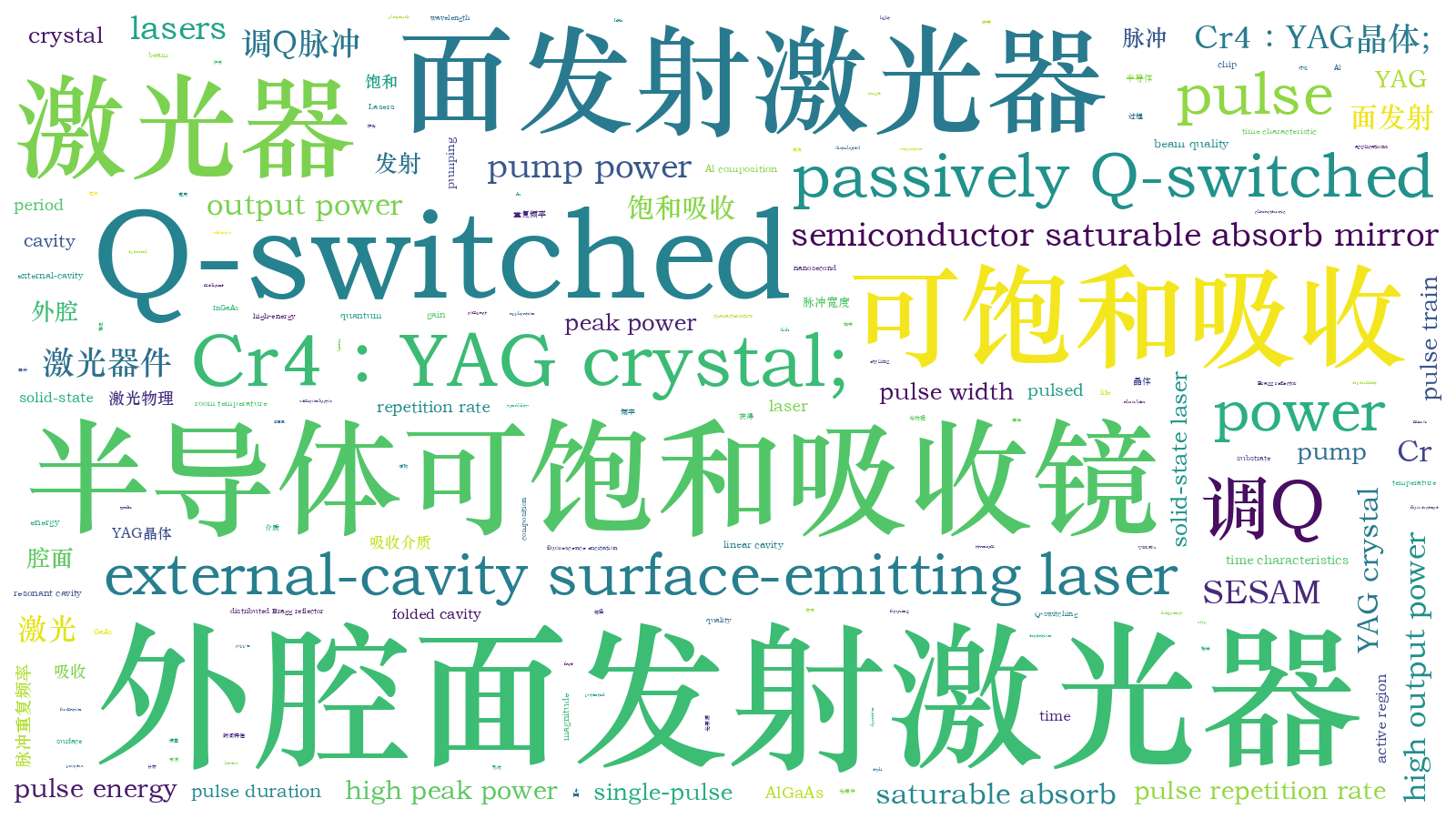调Q运转外腔面发射激光器  下载: 1135次
下载: 1135次
Objective Optically-pumped vertical-external-cavity surface-emitting lasers (OP-VECSELs) combine advantages of vertical-cavity surface-emitting lasers (VCSELs) and solid-state disk lasers. In addition, OP-VECSELs can produce high output power and good beam quality simultaneously. VECSELs are of interest in many fields due to the tailorability and tunability of emitting wavelengths. In addition, pulsed VECSELs with high-energy and high peak power are of considerable demand in applications such as frequency conversion, fluorescence excitation, and laser medicine. Q-switched VECSEL has been reported once, but it has not been investigated specifically and extensively, and there is no published experimental or theoretical work on a Q-switched VECSEL so far. This study introduced passively Q-switched VECSELs with a Cr 4+∶YAG crystal and a semiconductor saturable absorb mirror (SESAM), respectively. Based on the time characteristics of the quantum wells in the active region of the VECSELs and the time behaviors of the saturable absorbers (the Cr 4+∶YAG crystal and the SESAM), the experimental results were analyzed, and the formation mechanisms of the microsecond pulses were proposed.
Methods The gain chip used in the VECSELs is epitaxially grown on a GaAs substrate in reverse sequences as following: an etch stop layer of AlGaAs with high Al composition, a protective layer of GaAs, an AlGaAs layer with a high barrier, an active region comprising 12 InGaAs/GaAsP quantum wells (designed to meet a target laser wavelength of 980 nm), and a distributed Bragg reflector (DBR, which is composed of 30 pairs alternate AlGaAs layers with high and low Al composition). When the grown wafer is split into small chips with 4 mm×4 mm dimension, the epitaxial end face of the chips are sequentially metalized with titanium-platinum-aurum; then, the chips are bonded to a copper heatsink, and the substrate is removed using a chemical etching. The passively Q-switched VECSEL with Cr 4+∶YAG crystal uses a linear cavity, and the Q-switching crystal is placed to the gain chip as near as possible during the experiment, while the passively Q-switched VECSEL with SESAM uses a folded cavity, and the length of the arm containing the gain chip is longer than that of the arm with SESAM to produce a tighter focusing of the light on SESAM, to satisfy the need of SESAM saturation and start the Q-switching process.
Results and Discussions When a Cr 4+∶YAG crystal is placed into the resonant cavity, a stable pulse train is obtained. Under room temperature and 4.5 W pump power, the pulse width and period are 10 and 38 μs, respectively, corresponding to a repetition rate of 26.3 kHz (Fig. 5). As SESAM is inserted into the folded cavity, a steady pulse train is produced, and the pulse width and period are 8 and 38 μs, respectibvely (Fig. 6), corresponding to a repetition rate of 26.3 kHz (the same as that in the Cr 4+∶YAG Q-switched VECSEL) under room temperature and 4.5 W pump power. The maximum average output power of the SESAM Q-switched VECSEL is 33 mW, the repetition rate is 58.1 kHz, and the single-pulse energy is 0.57 μJ when the pump power is 7.2 W (Fig. 8). The relationship between pulse periods and pump powers of the Q-switched VECSELs is different from a typical Q-switched solid-state laser. In a passively Q-switched solid-state laser, the pulse period decreases reciprocally with the increase in pumping power; however, for the passively Q-switched VECSELs, the pulse period decreases approximately exponentially (Fig. 7), and we believe this is due to the short life of the nanosecond magnitude of carriers in the active region of the VECSELs.
Conclusions We have demonstrated passively Q-switched VECSELs with Cr 4+∶YAG crystal and SESAM, respectively. The pulse widths of the Cr 4+∶YAG and SESAM Q-switched VECSEL are 10 and 8 μs, respectively, with the same repetition rate of 26.3 kHz when the pump power is 4.5 W. A maximum average output power of 33 mW is obtained from the SESAM Q-switched VECSEL with 7.2 W pump power, and the pulse repetition rate is 58.1 kHz, corresponding to a single-pulse energy of 0.57 μJ. With the increase in pump power, the pulse period decreases approximately exponentially in the Q-switched VECSELs instead of reciprocally in a typical Q-switched solid-state laser. The time characteristic of quantum wells in active region, i.e., the short life time of nanosecond magnitude of carriers, is the reason the pulse duration is of microsecond magnitude. Since the VECSELs can produce high output power and good beam quality simultaneously, these compact and wavelength tailorable passively Q-switched VECSELs have potential application in many fields when the average output power is improved and the pulse peak power is upgraded.
张晓健, 潘丽, 曾颖, 张洲, 杨红伟, 王彦照, 王涛, 朱仁江, 范嗣强, 张鹏. 调Q运转外腔面发射激光器[J]. 中国激光, 2021, 48(7): 0701003. Xiaojian Zhang, Li Pan, Ying Zeng, Zhou Zhang, Hongwei Yang, Yanzhao Wang, Tao Wang, Renjiang Zhu, Siqiang Fan, Peng Zhang. Q-Switched External-Cavity Surface-Emitting Lasers[J]. Chinese Journal of Lasers, 2021, 48(7): 0701003.







